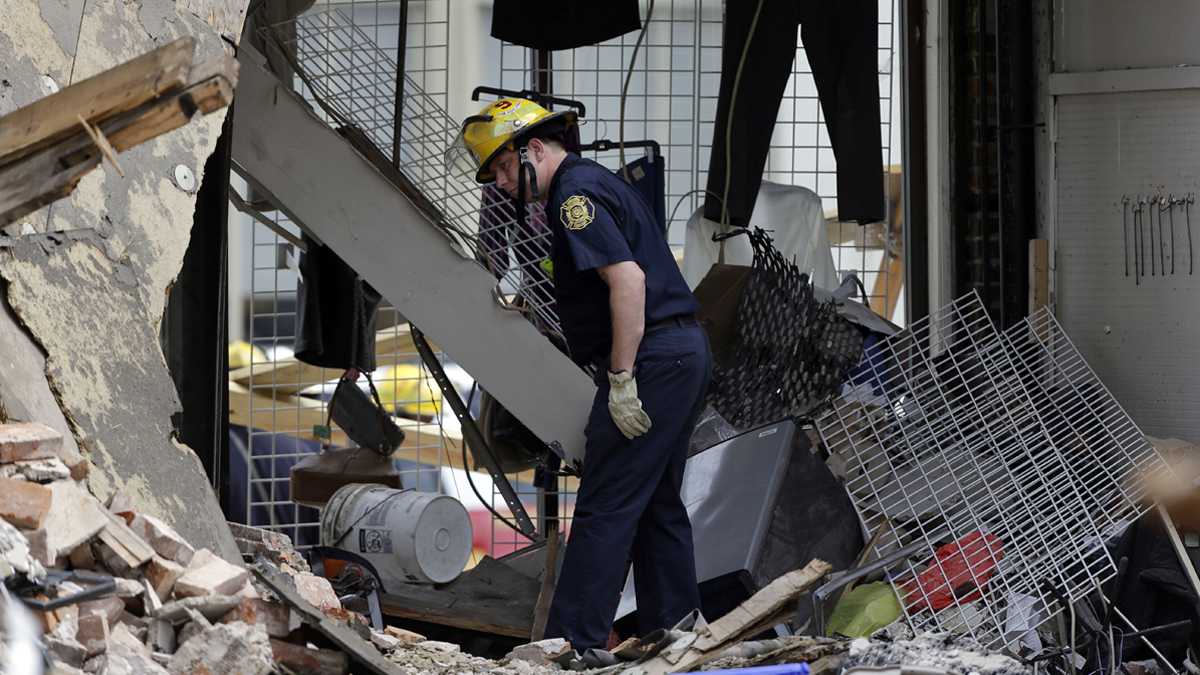Civil trial over Philly building collapse goes to the jury
Listen
A firefighter walks through the aftermath of a building that collapsed in Center City
After more than four months, jurors are expected to begin deliberations this week in the civil trial tied to June 2013’s deadly building collapse in Center City Philadelphia.
On Wednesday, the panel finished listening to closing arguments, which spanned two full days and featured a variety of conclusions about who is to blame and who is financially liable for one of the city’s most tragic days in recent history.
Plaintiffs’ attorney Robert Mongeluzzi told jurors the building owner Richard Basciano, project manager Thomas Simmonds and the owner’s representative Plato Marinakos were all negligent, but particularly Basciano and his company STB Investments Corp.
Basciano, said Mongeluzzi, set in motion a series of decisions that ultimately led to the collapse at 22nd and Market Streets on June 5, 2013.
Basciano hired Simmonds and Marinakos to do jobs they had no experience doing, said Mongeluzzi. Marinakos hired general contractor Griffin Campbell, who had only demolished a pair of burned out row homes.
“They hired the bull. They put the bowls in the china shop,” said Mongeluzzi.
Defense attorneys spent most of the day arguing that none of their clients should shoulder responsibility for what unfolded nearly four years ago.
At around 10:41 a.m. that day, an unbraced, three-story wall of a building being demolished collapsed onto and crushed a busy one-story thrift store owned by The Salvation Army.
Six people were killed. Thirteen more were injured.
During his nearly two-hour pitch, defense attorney Richard Sprague, who represents building owner Basciano, told jurors the collapse was a “horrible, horrible catastrophe.” But, he said his client couldn’t be held responsible because he didn’t intentionally harm anyone.
When Marinakos, an architect by trade, recommended demolition contractor Griffin Campbell, Sprague said Basciano trusted that Campbell was reputable because he trusted Marinakos.
He didn’t think Marinakos would put up someone who had never taken down a commercial building before and didn’t have the right licenses, as was the case with Campbell. He didn’t know Marinakos would be guiding Campbell, Sprague said.
“Why would they have reason to disbelieve [Marinakos]?” asked Sprague.
At the start of Wednesday, defense attorney Neil Clain, who represents Marinakos, argued that his client was never the one pulling the strings on the project, especially when it came to Campbell and excavator operator Sean Benschop, who Clain blamed for the collapse.
Moments before the building collapsed, Benschop was behind the wheel of his excavator, chipping away at the eastern wall of the property.
“He was the person who brought this building down,” said Clain.
Benschop plead guilty to involuntary manslaughter and aggravated assault and is serving a 7½- to-15-year prison sentence. Campbell, who hired him, was sentenced to 15-to-30 years after a jury found him guilty of the same charges.
Clain said Marinakos only recommended Campbell. It was Basciano who ultimately hired him and, therefore, is responsible for his actions.
Defense attorney John Snyder said The Salvation Army is also blameless.
“It wasn’t The Salvation Army’s project. It wasn’t The Salvation Army’s contractor. It wasn’t The Salvation Army’s excavator operator who knocked the building down,” he said.
The plaintiffs’ attorneys have argued the charity ignored a series of e-mails from project manager Thomas Simmonds warning that the building was a public safety threat.
They’ve also maintained it put lives at risk because it didn’t work out a deal with Basciano that would have allowed demolition workers on the thrift store’s roof to take down the unbraced wall by hand.
On Wednesday, Snyder balked at both arguments, saying only opposing lawyers thought the exchanges from Simmonds — sent in the weeks before the collapse — were actually rooted in reality. He called the roof argument “absurd.”
“It’s all made up,” said Snyder. “This is a big shell game going on here.”
It could take several days before the jury returns with verdict. Once jurors decide who is financially responsible, they’ll have to determine how much each plaintiff is owed. Payouts could total in the millions.
WHYY is your source for fact-based, in-depth journalism and information. As a nonprofit organization, we rely on financial support from readers like you. Please give today.


